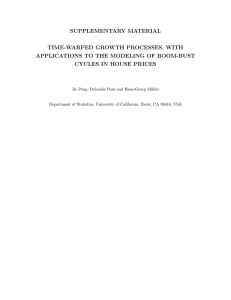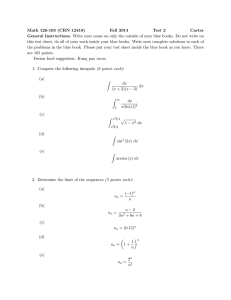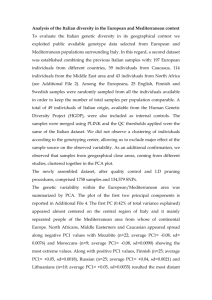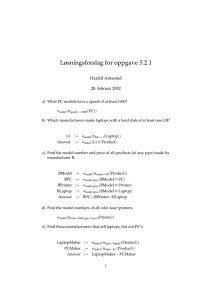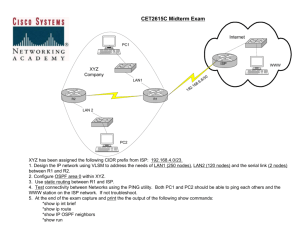Constitutive Activation of G-proteins by Polycystin-1 Is Antagonized by Polycystin-2*
advertisement
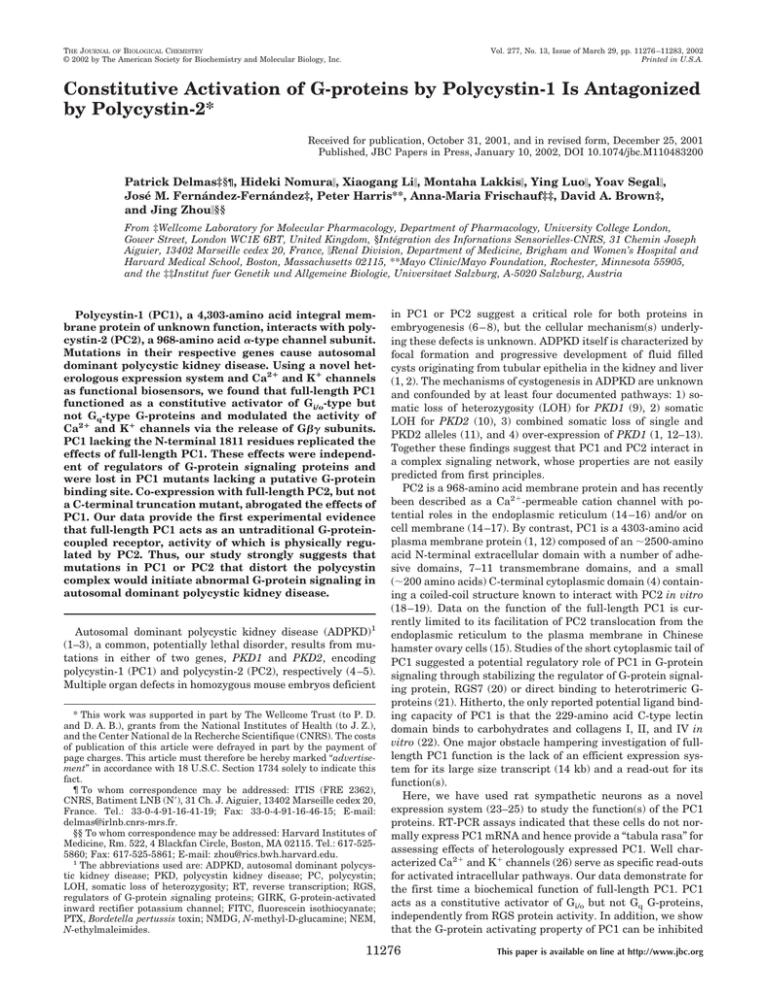
THE JOURNAL OF BIOLOGICAL CHEMISTRY © 2002 by The American Society for Biochemistry and Molecular Biology, Inc. Vol. 277, No. 13, Issue of March 29, pp. 11276 –11283, 2002 Printed in U.S.A. Constitutive Activation of G-proteins by Polycystin-1 Is Antagonized by Polycystin-2* Received for publication, October 31, 2001, and in revised form, December 25, 2001 Published, JBC Papers in Press, January 10, 2002, DOI 10.1074/jbc.M110483200 Patrick Delmas‡§¶, Hideki Nomura储, Xiaogang Li储, Montaha Lakkis储, Ying Luo储, Yoav Segal储, José M. Fernández-Fernández‡, Peter Harris**, Anna-Maria Frischauf‡‡, David A. Brown‡, and Jing Zhou储§§ From ‡Wellcome Laboratory for Molecular Pharmacology, Department of Pharmacology, University College London, Gower Street, London WC1E 6BT, United Kingdom, §Intégration des Infornations Sensorielles-CNRS, 31 Chemin Joseph Aiguier, 13402 Marseille cedex 20, France, 储Renal Division, Department of Medicine, Brigham and Women’s Hospital and Harvard Medical School, Boston, Massachusetts 02115, **Mayo Clinic/Mayo Foundation, Rochester, Minnesota 55905, and the ‡‡Institut fuer Genetik und Allgemeine Biologie, Universitaet Salzburg, A-5020 Salzburg, Austria Polycystin-1 (PC1), a 4,303-amino acid integral membrane protein of unknown function, interacts with polycystin-2 (PC2), a 968-amino acid ␣-type channel subunit. Mutations in their respective genes cause autosomal dominant polycystic kidney disease. Using a novel heterologous expression system and Ca2ⴙ and Kⴙ channels as functional biosensors, we found that full-length PC1 functioned as a constitutive activator of Gi/o-type but not Gq-type G-proteins and modulated the activity of Ca2ⴙ and Kⴙ channels via the release of G␥ subunits. PC1 lacking the N-terminal 1811 residues replicated the effects of full-length PC1. These effects were independent of regulators of G-protein signaling proteins and were lost in PC1 mutants lacking a putative G-protein binding site. Co-expression with full-length PC2, but not a C-terminal truncation mutant, abrogated the effects of PC1. Our data provide the first experimental evidence that full-length PC1 acts as an untraditional G-proteincoupled receptor, activity of which is physically regulated by PC2. Thus, our study strongly suggests that mutations in PC1 or PC2 that distort the polycystin complex would initiate abnormal G-protein signaling in autosomal dominant polycystic kidney disease. Autosomal dominant polycystic kidney disease (ADPKD)1 (1–3), a common, potentially lethal disorder, results from mutations in either of two genes, PKD1 and PKD2, encoding polycystin-1 (PC1) and polycystin-2 (PC2), respectively (4 –5). Multiple organ defects in homozygous mouse embryos deficient * This work was supported in part by The Wellcome Trust (to P. D. and D. A. B.), grants from the National Institutes of Health (to J. Z.), and the Center National de la Recherche Scientifique (CNRS). The costs of publication of this article were defrayed in part by the payment of page charges. This article must therefore be hereby marked “advertisement” in accordance with 18 U.S.C. Section 1734 solely to indicate this fact. ¶ To whom correspondence may be addressed: ITIS (FRE 2362), CNRS, Batiment LNB (N⬘), 31 Ch. J. Aiguier, 13402 Marseille cedex 20, France. Tel.: 33-0-4-91-16-41-19; Fax: 33-0-4-91-16-46-15; E-mail: delmas@irlnb.cnrs-mrs.fr. §§ To whom correspondence may be addressed: Harvard Institutes of Medicine, Rm. 522, 4 Blackfan Circle, Boston, MA 02115. Tel.: 617-5255860; Fax: 617-525-5861; E-mail: zhou@rics.bwh.harvard.edu. 1 The abbreviations used are: ADPKD, autosomal dominant polycystic kidney disease; PKD, polycystin kidney disease; PC, polycystin; LOH, somatic loss of heterozygosity; RT, reverse transcription; RGS, regulators of G-protein signaling proteins; GIRK, G-protein-activated inward rectifier potassium channel; FITC, fluorescein isothiocyanate; PTX, Bordetella pertussis toxin; NMDG, N-methyl-D-glucamine; NEM, N-ethylmaleimides. in PC1 or PC2 suggest a critical role for both proteins in embryogenesis (6 – 8), but the cellular mechanism(s) underlying these defects is unknown. ADPKD itself is characterized by focal formation and progressive development of fluid filled cysts originating from tubular epithelia in the kidney and liver (1, 2). The mechanisms of cystogenesis in ADPKD are unknown and confounded by at least four documented pathways: 1) somatic loss of heterozygosity (LOH) for PKD1 (9), 2) somatic LOH for PKD2 (10), 3) combined somatic loss of single and PKD2 alleles (11), and 4) over-expression of PKD1 (1, 12–13). Together these findings suggest that PC1 and PC2 interact in a complex signaling network, whose properties are not easily predicted from first principles. PC2 is a 968-amino acid membrane protein and has recently been described as a Ca2⫹-permeable cation channel with potential roles in the endoplasmic reticulum (14 –16) and/or on cell membrane (14 –17). By contrast, PC1 is a 4303-amino acid plasma membrane protein (1, 12) composed of an ⬃2500-amino acid N-terminal extracellular domain with a number of adhesive domains, 7–11 transmembrane domains, and a small (⬃200 amino acids) C-terminal cytoplasmic domain (4) containing a coiled-coil structure known to interact with PC2 in vitro (18 –19). Data on the function of the full-length PC1 is currently limited to its facilitation of PC2 translocation from the endoplasmic reticulum to the plasma membrane in Chinese hamster ovary cells (15). Studies of the short cytoplasmic tail of PC1 suggested a potential regulatory role of PC1 in G-protein signaling through stabilizing the regulator of G-protein signaling protein, RGS7 (20) or direct binding to heterotrimeric Gproteins (21). Hitherto, the only reported potential ligand binding capacity of PC1 is that the 229-amino acid C-type lectin domain binds to carbohydrates and collagens I, II, and IV in vitro (22). One major obstacle hampering investigation of fulllength PC1 function is the lack of an efficient expression system for its large size transcript (14 kb) and a read-out for its function(s). Here, we have used rat sympathetic neurons as a novel expression system (23–25) to study the function(s) of the PC1 proteins. RT-PCR assays indicated that these cells do not normally express PC1 mRNA and hence provide a “tabula rasa” for assessing effects of heterologously expressed PC1. Well characterized Ca2⫹ and K⫹ channels (26) serve as specific read-outs for activated intracellular pathways. Our data demonstrate for the first time a biochemical function of full-length PC1. PC1 acts as a constitutive activator of Gi/o but not Gq G-proteins, independently from RGS protein activity. In addition, we show that the G-protein activating property of PC1 can be inhibited 11276 This paper is available on line at http://www.jbc.org PC2 Inhibits G-protein Activation by PC1 11277 MATERIALS AND METHODS FIG. 1. Cell surface expression of polycystin-1. Proposed membrane topology for hPC1 (A) and mPC1 (B). The 11 TM topology is shown. PC1 is predicted to have an extensive, N-terminal extracellular region that contains several functional motifs and a small, C-terminal cytoplasmic tail known to interact with PC2. REJ: receptor for egg jelly; Ig: Ig-like repeat. C, corresponding images showing a rat-sympathetic neuron (bright field, top panel) intranuclearly injected with hPC1 cDNA together with a fluorescent marker (FITC, middle panel) and stained with the anti-hPC1 antibody MR3 (bottom). Note the strong labeling of the cell surface. The arrow indicates an uninjected neuron. Bar scale, 20 m. D, confocal sections of a neuron microinjected with cDNA encoding Myc-tagged mPC1 and stained using anti-Myc antibody (green) and an antibody against voltage-dependent N-type Ca2⫹ channels (␣1b) (VDCC, red). Antigens were stained after fixing. Note in the overlay that the two proteins co-localize at the plasma membrane. E, expression of full-length Myc-tagged mPC1 (lane 1) and untagged mPC1 (lane 2) in 5454 and Hek293 mammalian cell lines. Precleared cell lysates were immunoprecipitated (IP) with either monoclonal anti-Myc antibody (lane 1) or the monoclonal anti-mPC1 antibody, 7e12 (lane 2). by the cation channel PC2 via interactions of their C termini. Taken together, our data indicate that mutations in PC1 or PC2 may have a “dosage effect” such that mutations perturbing but not necessarily abrogating the polycystin complex initiate abnormal G-protein signaling pathways in cells that naturally co-express both PC1 and PC2. DNA Constructs—The human PKD1 expression construct was assembled from cDNA clones KG8, RT-PCR product puK3139, and a fragment of cDNA clone FK7 in pcDNA3.1/His-C (Invitrogen) through various digestion and ligation procedures. The final construct contains a partial 8428-bp cDNA of human PKD1, encoding the C-terminal 2492 amino acids of polycystin-1, with an “Xpress tag” at its N terminus. The full-length mouse PKD1 construct was assembled from cloned cDNA and RT-PCR products, sequence-verified for an open reading frame, and cloned into pcDNA3.1 at NotI site. The final construct encodes the entire mouse polycystin-1 (4303 amino acids). mPKD1-Myc tagged construct (pcDNA-PKD1-Myc) was generated by PCR-directed mutation of in-frame stop codons from pcDNA-PKD1. The mPC1 mutant was generated by a deletion of the last 193 amino acids of mouse polycystin-1. The C-terminal-deleted region includes a binding domain for heterotrimeric G-proteins, a G-protein activation peptide (21), and putative interaction site with PC2. The mPC2 mutant was generated as described (40) and subcloned into pcDNA3.1 by standard procedures. This mutant lacks the C-terminal 226-amino acids of PC2, which includes the EF-hand and the putative PC1 interaction domain. Primary Neuronal Cultures and Nuclear Microinjection—Sympathetic neurons were dissociated from superior cervical ganglia of 15- to 19-day-old male Sprague-Dawley rats and cultured on laminin-coated glass coverslips as described (25). Plasmids were diluted in Ca2⫹-free Krebs solution (290 mosmol l⫺1, pH 7.3) containing 0.5% FITC-dextran (70 kDa, Molecular Probes) to a final concentration of 100 g ml⫺1 (Kir3.1 and Kir3.2 cDNAs), 200 g ml⫺1 (hPKD1, mPKD1, mPKD2, GABABR1b, GABABR2, G1, G␥2, and G␣-transducin cDNAs) or 40 g ml⫺1 (G-protein ␣ mutants). Plasmids were pressure-injected into the nucleus of sympathetic neurons with sharp micropipettes (50 – 60 M⍀) using manual impalement (24) or automated microinjection (37) (Eppendorf, Hamburg, Germany). Neurons were maintained in culture for a further 2 days prior to recording or immunostaining. cDNAs for bovine 1 and ␥2 G-protein subunits, retinal G␣ transducin, Kir3.1/3.2 and GABABR1b/R2 subunits were described previously (25, 34, 38). PTX- and RGS-insensitive G-protein ␣oA/i1 subunits were generated by point mutation of Cys-3513 Ile and Gly-183/1843 Ser as detailed (39). All constructs were subcloned in cytomegalovirus promoter vectors and verified by automated DNA sequencing. Cells expressing G␣oA-G184S showed a ⬎10-fold slower recovery from Ca2⫹ current inhibition by noradrenaline, confirming that G␣oA mutants are resistant to the action of endogenous RGS proteins. Immunoblotting—Myc-tagged mPC1 and untagged mPC1 were transiently transfected into 5454 cells and Hek293 cells, respectively. Precleared cell lysates were incubated with an anti-Myc antibody (Santa Cruz) or the anti-PC1 antibody 7e12 (27) at 4 °C for 12 h. Immunocomplexes were then captured with protein A beads for 2 h. The beads were washed, and bound proteins were then fractionated by SDS-PAGE followed by Western blot analysis. Western blots were probed with an anti-Myc polyclonal antibody (Zymed Laboratories Inc.) or 7e12 prior to their incubation with horseradish peroxidase-coupled antibody. Immobilized antibodies were detected by ECL. Patch Clamp Recording—Neurons were recorded using the whole cell variants (patch-ruptured or perforated patch) of the patch clamp technique. For recording of Ca2⫹ currents and leak and M-type K⫹ currents, the external solution was (mM): NaCl, 110; NaHCO3, 23; KCl, 3; MgCl2, 1.2; CaCl2, 2.5; Hepes, 5; glucose, 11; tetrodotoxin, 0.0005 (bubbled with a 95% O2-5% CO2 mixture, pH 7.4). GIRK1/2 currents were recorded using the same external solution, except that [K⫹]o was 12 mM (isosmotically compensated for Na⫹). Ca2⫹ and GIRK1/2 currents were obtained using patch-ruptured whole-cell recording. Pipettes were coated with Sylgard and had resistance of 2–3.5 M⍀. Internal solution for ICa was (mM): 120 NMDG, 14 CsCl, 10 Hepes, 11 EGTA, 0.5–1 CaCl2, 0.1 phosphocreatine, 4 MgATP and 0.2 Na3GTP (pH 7.3). Currents were measured with an Axopatch 200A amplifier, filtered at 1–5 kHz, and leak-subtracted using the leak subtraction procedure (P/6) of the pClamp software (Axon Instruments). Cell membrane capacitance and series resistance compensations were applied (75– 85%). In experiments where GDP--S (3 mM) was added to the pipette solution, GTP was omitted. Ca2⫹ currents were evoked using a triple-pulse voltage protocol, and facilitation was calculated as the ratio (P2/P1) of Ca2⫹ current amplitude (see Fig. 3). The intracellular solution for GIRK1/2 current consisted of (mM): KCl, 60; potassium acetate, 60; MgCl2, 2.5; Hepes, 30; BAPTA (1,2-bis(2-aminophenoxy)ethane-N,N,N⬘,N⬘-tetraacetic acid), 10; Na2ATP, 2; and Na3GTP, 0.1 (adjusted to pH 7.2 with KOH and 290 mosmol l⫺1). Currents were recorded with an Axoclamp 2B amplifier (discontinuous 11278 PC2 Inhibits G-protein Activation by PC1 FIG. 2. Polycystin-1 does not form cation channels in neurons. A, representative current-voltage (I-V) relationships obtained in control neurons (injected with green fluorescent protein cDNA) and in neurons expressing hPC1 or mPC1. The thin lines (linear regression) represent the leak conductance extrapolated from the ⫺60/⫺80 mV voltage region. Leak conductance is given normalized to the cell capacitance for comparison. B, I-V relationships minus leak currents, isolating inward and outward rectifications. Note that the reduction in the outward K⫹ rectification in hPC1- and mPC1-expressing neurons results indirectly from the inhibition of Ca2⫹ channels (see below and Fig. 3). mode), low-pass filtered at 1 kHz, and sampled at 6.67 kHz. GIRK1/2 currents were typically evoked by 700 ms voltage ramps from ⫺140 to ⫺40 mV. The amplitude of GIRK1/2 currents was measured as the Ba2⫹-sensitive current (100 M) averaged between ⫺125 and ⫺130 mV. Leak currents were not subtracted. Recording of passive membrane properties (Fig. 2) and M-current was made using the perforated patch clamp technique to avoid rundown (37). Patch pipettes were filled by dipping the tip for 40 s into filtered internal solution that comprised (mM): K⫹ acetate, 80; KCl, 30; Hepes, 40; MgCl2, 3 (pH 7.35). Pipettes were then back-filled with the same internal solution containing 0.09 mg/ml amphotericin-B. After permeabilization, access resistances were 10 –15 M⍀. Leak currents were not subtracted, otherwise mentioned (e.g. Fig. 2). Experiments were performed at 30 –32 °C, and drugs were applied by using a gravityfed perfusion system (10 ml min⫺1). NEM (N-ethylmaleimide) was applied at 50 M for at least 2 min, and PTX was incubated 12–24 h at 1 g ml⫺1. Data are expressed as means ⫾ S.E. Statistical analysis was performed using Student’s t tests or two-way analysis of variance as appropriate. Immunocytochemistry—Myc-tagged mPC1:cells were fixed with 4% paraformaldehyde for 20 –25 min at room temperature followed by 5 min treatment with Triton (0.1%) to permeabilize membranes. After incubation with bovine serum albumin/phosphate-buffered saline, neurons were incubated with anti-Myc antibody for 1 h, washed, and then stained with FITC-conjugated anti-mouse antibody (1/100) for 35 min. Fluorescence images were obtained using a confocal microscope (BioRad). The anti-human PC1 polyclonal antibodies MR3 (12) were used to examine the expression of the human PKD1 construct. After fixation with acetone for 5 min, cells were incubated for 2–3 h at room temperature with MR3 polyclonal antibodies (1:50). Polyclonal anti-␣1B subunit antibodies (ACC-002, Alomone) were used at 1/200. Bound antibodies were then detected using FITC- or tetramethylrhodamine isothiocyanate-conjugated secondary antibodies (1/100 –200) (DAKO A/S, Denmark). Images were collected with an Axiophot fluorescence microscope (Zeiss, Germany) or a confocal microscope. Immunostaining was performed 2 days post-injection. RESULTS Polycystin-1 Homomers Expressed in Neurons Do Not Form Ion Channels—Cultured sympathetic neurons were microinjected intranuclearly with cDNAs encoding full-length mPC1 or N-terminal-truncated hPC1 lacking the Ig-like repeat (Fig. 1, A and B), and somatic recordings were made 48 h later using the perforated patch clamp technique. Neurons so injected efficiently expressed PC1 in their outer membrane (Fig. 1, C and D). Immunostaining using an anti-hPC1 polyclonal antibody (MR3) (12) revealed immunoreactivity concentrated at the cell periphery in 78% of cells microinjected with hPKD1 cDNA (n ⫽ 26) (Fig. 1C). Further, Myc-tagged mPC1 was co-immunolabeled with the ␣1B Ca2⫹ channel subunit, a typical plasma membrane protein. Confocal sections showed that Myc-tagged mPC1 co-localized with Ca2⫹ channels in the plasma membrane and was not retained intracellularly (Fig. 1D). Western blot analysis from mammalian cell lines transfected with DNA constructs for full-length mPC1 and Myc-tagged mPC1 revealed proteins of ⬃460 kDa, which is similar to the predicted size of PC1 encoded by the longest open-reading frame of PC1 (460 kDa) (Fig. 1E). Electrophysiological recording in neurons revealed that, unlike PC2 (16 –17) and polycystin-L (28), expressed PC1 protein did not function as a cation channel (n ⫽ 12; Fig. 2) in accordance with recent studies in Chinese hamster ovary cells (15); nor do they up-regulate endogenous cation-permeable channels in these cells, as recently reported for an expressed PC1 Cterminal fragment (PC1C1–226) in oocytes (29). Polycystin-1 Modulates Voltage-dependent Ca2⫹ Channels and GIRK K⫹ Channels—To assess the role of PC1 in signal PC2 Inhibits G-protein Activation by PC1 11279 FIG. 3. Polycystin-1 mimics G␥ modulation of Ca2ⴙ currents by activating Gi/o-type G-proteins. Representative Ca2⫹ current traces recorded in an uninjected neuron (A) and in neurons expressing either G1␥2 (B) or mPC1 (C). Ca2⫹ currents were evoked before (P1) and after (P2) a depolarizing prepulse to ⫹90 mV (top left inset). Note that NEM (50 M), a Gi/o G-protein inhibitor, blocked the voltage-dependent inhibition induced by mPC1 but not that by G1␥2. D, current-voltage relationships measured 7 ms after the start of the step for the Ca2⫹ currents in P1 in neurons microinjected with FITC (n ⫽ 6), G1␥2 cDNA (n ⫽ 12), and mPC1 cDNA (n ⫽ 14). Points are mean ⫾ S.E. (E and F) representative Ca2⫹ current traces in neurons expressing hPC1 either alone (E) or together with G␣ transducin (F). Note that ␣ transducin blocked hPC1-induced facilitation of Ca2⫹ currents. G, intrapipette diffusion of GDP--S reversed mPC1-induced modulation. Ca2⫹ currents were recorded 1 min after achieving the whole-cell configuration (tick line) in the presence of 3 mM internal GDP--S and then every 4 min (arrows). H, summary of facilitation (taken as an index of voltage-dependent inhibition) observed in neurons under the different conditions indicated. PTX, pertussis toxin; G␣t, G␣ transducin. ***, p ⬍ 0.001 versus Control. Facilitation was calculated as the ratio (P2/P1) of postpulse to prepulse currents. transduction, we looked at the activity of N-type Ca2⫹ channels and inwardly rectifying GIRK1/2 K⫹ channels (Kir3.1,3.2 subunits), well known to be regulated by G-protein-coupled receptors (26, 30 –31) through direct gating by G␥ subunits (23, 32–33). Fig. 3 shows the effects of hPC1 and mPC1 on the N-type Ca2⫹ channels present in these cells (34). Expression of PC1 produced a strong inhibition of their activity. In effect, hPC1 and mPC1 were as effective as over-expressing G1␥2, reducing Ca2⫹ current density at 0 mV from 33 ⫾ 3 pA/pF in control neurons to 19 ⫾ 4, 22 ⫾ 3, and 17 ⫾ 2 pA/pF, respectively (n ⫽ 10 –14). A typical trademark of G␥-mediated modulation of Ca2⫹ channels is the relief of inhibition by depolarizing voltages, a phenomenon termed facilitation (23) that results from the voltage-dependent dissociation of G␥ from the Ca2⫹ channel (Fig. 3B). Like the action of G␥, mPC1 or hPC1 mimicked the voltage-dependent facilitation of Ca2⫹ channels and produced a depolarizing shift of the I-V curves for Ca 2⫹ channel activation (Fig. 3, C–E). The results obtained on recording Ca2⫹ currents were qual- itatively replicated using GIRK1/2 channels as biosensors for G-protein activation. GIRK1/2 channels were expressed heterologously in sympathetic neurons (35). In the presence of 12 mM external K⫹, these channels generate inwardly rectifying currents (Fig. 4). In cells expressing GIRK1/2 channels, both hPC1 and mPC1 significantly increased basal GIRK1/2 current from 10 ⫾ 1 pA/pF in control neurons to 22 ⫾ 2 and 27 ⫾ 4 pA/pF, respectively (Fig. 4, D, E, and G). Here again, PC1 activation of GIRK1/2 currents was quantitatively comparable with that caused by G1␥2 (23 ⫾ 4 pA/pF) (Fig. 4, C and G). Polycystin-1 Modulates Ion Channels via Gi/o-protein Activation and G␥ Release—Taken together, these results indicate that PC1-mediated effects were phenomenologically identical to those produced by G␥. To test whether PC1 was releasing G␥ from endogenous G-protein heterotrimers or simply mimicking the action of G␥ on ion channels, we expressed the G␥-sequestering agent G␣ transducin (24 –25, 34) together with PC1. G␣ transducin fully abolished the action of hPC1 on both Ca2⫹ channels (Fig. 3, F and H) and GIRK1/2 channels 11280 PC2 Inhibits G-protein Activation by PC1 FIG. 4. G␥-mediated activation of GIRK1/2 channels by polycystin-1. A–F, GIRK1/2 currents in an uninjected neuron (B) and in neurons expressing G1␥2 (C), mPC1 (D), hPC1 (E), and hPC1 together with G␣ transducin (F). In each recording, GIRK1/2 current was identified as the current blocked by 100 M Ba2⫹. Note again that NEM blocked the tonic activation of GIRK1/2 by mPC1 and hPC1 but not by G1␥2. The effects of NEM in control cells and in cells expressing G1␥2 result from the basal turnover of endogenous Gi/Go G-proteins. The voltage protocol is shown in A. G, summary of activation of GIRK1/2 current observed in neurons under the different conditions indicated. **, p ⬍ 0.01; ***, p ⬍ 0.001 versus Control. (Fig. 4, F and G), indicating that PC1 mediates its effects by releasing G␥ complexes from their association with G␣ subunits. By analogy with G-protein-coupled 7TM receptors, we hypothesized that PC1 directly activates G-proteins and catalyzes GTP binding to the G␣ subunit (21). We tested this by intracellularly dialyzing the non-hydrolyzable GDP analogue, GDP-S, in mPC1-expressing neurons. GDP--S (3 mM) reversed the effects of mPC1 on Ca2⫹ channels by 74 ⫾ 5% (n ⫽ 5) within 15–20 min of intracellular diffusion (Fig. 3, G and H). The properties of Ca2⫹ channel inhibition by PC1 as well as the modulation of GIRK1/2 channels suggested that PC1 couples to Gi/o-type G-proteins, since similar receptor-mediated effects result from activation of this family of G-proteins (30 – 31). The effects of PC1 were therefore assessed after pre-treatment with agents (Pertussis toxin and NEM, see “Materials and Methods”) that are known to prevent receptor/Gi/o-protein interaction. After these treatments, mPC1 and hPC1 no longer modulated either Ca2⫹ (Fig. 3, C, E, and H) or GIRK1/2 (Fig. 4, D, E, and G) channels. We confirmed that neither PTX nor NEM altered G␥ interaction with ion channels (Figs. 3B and 4C). In an additional set of experiments, we tested whether PC1 could activate Gq-type G-proteins by testing its ability to inhibit M-type K⫹ channels (36) (KCNQ channel family), which are selectively modulated via Gq-type G-proteins in rat-sympathetic neurons (37). There was no significant difference in the size of the M-current between uninjected neurons (4.4 ⫾ 0.3 pA/pF, n ⫽ 7) and neurons expressing mPKD1 (3.9 ⫾ 0.4 pA/pF, n ⫽ 5). To test whether the tonic activation of G-proteins could result from over-expression of PC1 (or any G-protein-coupled receptor), we over-expressed Gi/Go-coupled GABABR1b/R2 receptors (38). In the absence of ligand, over-expression of GABAB receptors did not produce tonic modulation of either Ca2⫹ channels (facilitation 1.16, n ⫽ 4; not shown) or GIRK1/2 channels (Fig. 4G). The successful expression of GABAB receptors was demonstrated by the 10-fold increased activation of GIRK1/2 in response to baclofen (50 M) (control cells: 7.5 ⫾ 1.5 pA/pF, n ⫽ 4; cells expressing GABABR1b/R2: 60.3 ⫾ 3.4 pA/pF, n ⫽ 7). Activation of Gi/o-proteins by Polycystin-1 Is Independent on RGS Proteins—Recently, RGS7, a member of the RGS proteins that act as GTPase activating proteins for G␣ subunits, has been shown to bind to the C terminus segment of PC1 (20). Using RT-PCR, RGS7 transcripts along with many others (RGS2, 4 –5, and 8) were detected in rat sympathetic neurons (data not shown). Although it is not known whether PC1/RGS7 complexes occur in vivo, we hypothesized that PC1 signals might be mediated via reduction of endogenous RGS-mediated GTPase activating protein activity. This would enhance the effects of any endogenously active G␣i/o G-proteins. To address this, we used G␣i/o mutants rendered insensitive to PTX and/or RGS proteins by point mutation of Cys-351 and Gly-183/184, which are sites for PTX-mediated ADP ribosylation and RGS binding, respectively (39). The actions of mutated G-proteins were isolated from those of native G␣i/o G-proteins by PTX treatment. Fig. 5 shows that heterologous expression of PTXinsensitive (C351I) G␣oA or G␣i1 mutants reconstituted mPC1 coupling to Ca2⫹ channels, G␣oA being slightly more efficient than G␣i1 (Fig. 5, B and C). Expression of either double mutants G␣oA (C351I/G184S) or G␣i1 (C351I/G183S) also restored mPC1-induced modulation of ion channel (Fig. 5, C and D), indicating that activation of G␣i/o subunits by PC1 was largely independent of RGS action. Interaction of Polycystin-2 with Polycystin-1 via Their C Termini Inhibits G-protein Activation by PC1—PC1 is thought to interact with PC2 through its C-terminal coiled-coil domain in vitro (18 –19). This site is only few amino acids downstream from the putative G-protein activating region (21) and may well influence G-protein binding. We therefore tested whether in vivo heterodimerization of PC1 and PC2 alters G-protein activation by PC1. In cells co-expressing full-length mPC1 and full-length mPC2 (1:1 ratio) G-protein-induced facilitation of Ca2⫹ currents was strongly repressed (Fig. 6, A and B). Consistently, basal activation of GIRK1/2 current was reduced by ⬃85% in cells co-expressing mPC1 and mPC2 compared with cells expressing mPC1 homomers (Fig. 6, B and D). mPC2 alone had no effect either on Ca2⫹ or GIRK channels (Fig. 6C). PC2 Inhibits G-protein Activation by PC1 11281 FIG. 5. Stimulation of G-proteins by PC1 is independent of RGS proteins. (A–C) neurons were pre-treated with PTX (500 ng/ml) for 24 h, and Ca2⫹ currents were recorded in neurons expressing mPC1 alone (A) or mPC1 together with PTX-insensitive G␣oA mutants (B) and PTX- and RGS-insensitive G␣oA mutants (C). Both mutants restore mPC1 signal. Neurons were microinjected with a ratio of cDNA (mPC1 versus G␣ mutant) of 1:0.2 to avoid possible G␥ sink by the ␣ subunits. D, summary of mPC1-induced facilitation in the presence or absence of PTX/RGS G␣oA and G␣i1 mutants. ns, not significant. These results suggest that co-assembly of PC2 with PC1 occludes G-protein binding/activation by PC1. To test whether these effects are dependent on an interaction at their respective C-terminal regions, we co-expressed the full-length mPC1 with an mPC2 mutant lacking the C-terminal 226 amino acids (R742X), which includes the putative PC1 interaction domain. Expression of mPC2 R742X failed to occlude mPC1 modulation of either Ca2⫹ or GIRK1/2 currents (Fig. 6, A, B, and D). Electrophysiological recordings of ion channel activity (Fig. 6A, inset) confirmed that mPC2 R742X was targeted to the plasma membrane in accordance with previous reports (15, 40). Expression of mPC2 R742X alone did not modulate either Ca2⫹ or GIRK1/2 currents (current densities of 9 ⫾ 2 pA/pF (n ⫽ 5) and 30 ⫾ 4 pA/pF (n ⫽ 4), respectively; compare with control values above). Further, expression of an mPC1 mutant that lacks the C-terminal 193 amino acids, including the putative binding domain for G-proteins and the interaction site with PC2, lost its ability to activate G-proteins and modulate GIRK1/2 or Ca2⫹ channels (n ⫽ 5–7) (Fig. 6, C and D). DISCUSSION In the present study, we have developed a mammalian expression system in which function of full-length polycystins can be tested. These cells (primary sympathetic neurons) are capable of rapidly expressing a wide variety of membrane receptors in functional form that need not be of neural origin and their complement of G-protein-regulated ion channels allows a convenient real-time readout of G-protein stimulation. Thus, though the downstream effectors we have used are largely neural-specific, and hence unlikely to be represented in cells that normally express polycystins, they provide valuable infor- mation regarding the primary events induced by polycystins that would be expected to apply to any cell. From this viewpoint, our data clearly show that PC1 acts as a Gi/o-protein-coupled receptor that regulates the activity of ion channels via Gi/o-proteins. Evidence that PC1 behaved as a G-protein-coupled receptor and directly activated G-proteins of the Gi/Go family to release ␥ subunits is provided by the facts that the effects of PC1 were reversed by: (a) dialyzing the cell interior with 3 mM of the non-hydrolyzable GDP analogue, GDP--S; (b) pretreatment with PTX or NEM, which prevents receptor/G-protein interaction; and (c) over-expressing the G␥-sequestering agent G␣ transducin. PC1 appeared to couple specifically to Gi/Go proteins since it did not inhibit M-type K⫹ channels, which are selectively modulated via Gq-type Gproteins in sympathetic neurons. These findings support the hypothesis that PC1 is involved in signal-transduction pathways, as suggested previously for the homologue of hPC1, LOV-1, in sensory neurons of Caenorhabditis elegans (41). PC1 may not require ligand binding to initiate G-protein signals since hPC1 lacking the N-terminal 1811 residues (extracellular domain) thought to be involved in cell-cell and/or cell-matrix interactions (22, 42, 43) replicated the effects of full-length mPC1 (though further experiments are needed to determine whether the REJ domain plays a role in G-protein activation). Our study also shows that co-assembly of PC2 with PC1 via their C termini inhibits the G-protein-activating properties of PC1. This is particularly important because in the kidney and many other tissues PC1 and PC2 are interacting partners, forming polycystin complexes (1). Thus, polycystin complex-disturbing mutations that result in either 11282 PC2 Inhibits G-protein Activation by PC1 FIG. 6. Co-expression of polycystin-2 repressed G-protein activation by PC1. A, Ca2⫹ current facilitation in neurons expressing mPC1 alone (left panel) and mPC1 together with fulllength mPC2 (middle) or mPC2 mutant R742X (right). Note the absence of facilitation in the cell co-expressing mPC1 and mPC2 and the strong facilitation in the cell expressing mPC2 R742X. The noise in the right panel resulted from the expression of the cation channel generated by mPC2 R742X, which is permeant to Ba2⫹ (n ⫽ 5) but not to NMDG⫹ (n ⫽ 8) (data not shown). An example of mPC2 R742X channel activity recorded with a cell-attached patch (146 mM Na⫹pipette, Vpipette 0 mV) is shown in the inset. Scale: 2 pA, 0.5 s. All whole-cell recordings were made in the absence of external Na⫹ (isoosmolarly substituted by NMDG⫹) and with Ba2⫹ (5 mM) as charge carrier. cDNAs: 200 ng/l and for co-expression 200 ng/l each. B, GIRK1/2 current recording in neurons expressing mPC1 alone (left panel) and mPC1 together with fulllength mPC2 (middle) or mPC2 R742X (right). Note the reduced basal activation of GIRK1/2 channels in the cell co-expressing mPC2 and the normal activation in the cell expressing mPC2 R742X. Recordings were made in the presence of 146 mM external Na⫹. mPC2/mPC1 consistently caused a smaller increase in holding current at ⫺60 mV than mPC2 R742X. cDNA was as in A. C, expression of an mPC1 mutant lacking 193 C-terminal residues does not induce Ca2⫹ current facilitation. D, summary of the effects of mPC2 and mPC1 on Ca2⫹ current facilitation (left) and activation of GIRK1/2 current (right). Recording conditions as in A and B. **, p ⬍ 0.01 versus mPC1. PC1 over-expression or loss of PC2 would “re-activate” G-protein signaling pathways. Indeed, PC1 over-expression in renal cysts is a general finding in almost all ADPKD patients (1, 12, 44). The current study thus provides a key missing piece of a puzzle, and links a long-standing immmunohistological observation with an important known signaling pathway. The results also offer a molecular explanation of the cystic kidney phenotype in transgenic mice over-expressing normal PC1 (13) and enlighten our understanding of the additive effects of the PKD1/PKD2 trans-heterozygous as a genetic basis for cystogenesis in ADPKD (11). G-protein-mediated signaling pathways involving adenylate cyclase and mitogen-activated protein kinases are known to control fluid secretion, cell proliferation, and differentiation. Abnormalities in these cell functions are central features of human ADPKD (1, 3). The identification of PC1 as a G-protein-coupled receptor potentially capable of activating such pathogenic pathways opens up new avenues for PKD research and provides a novel basis for the design of therapeutic strategies. Acknowledgments—We thank Graeme Milligan for the gift of G␣transducin, G1 and G␥2 cDNAs, R. R. Neubig for G-protein ␣ subunit mutants, Florian Lesage and Michel Lazdunski for Kir3.1 and Kir3.2 cDNAs, Alexander K. Filippov for GABABR1 and GABABR2 cDNAs, Michael Schneider and Stephen T. Reeders for scientific discussion, and Takeshi Yuasa for scientific discussion and technical assistance. PC2 Inhibits G-protein Activation by PC1 REFERENCES 1. Grantham, J. J. & Calvet, J. P. (2001) Proc. Natl. Acad. Sci. U. S. A. 98, 790 –792 2. Gabow, P. A. (1993) N. Engl. J. Med. 329, 332–342 3. Wu, G. & Somlo, S. (2000) Mol. Genet. Metab. 69, 1–15 4. Hughes, J., Ward, C. J., Peral, B., Aspinwall, R., Clark, K., San Millan, J. L., Gamble, V. & Harris, P.C. (1995) Nat. Genet. 10, 151–160 5. Mochizuki, T., Wu, G., Hayashi, T., Xenophontos, S. L., Veldhuisen, B., Saris, J. J., Reynolds, D. M., Cai, Y., Gabow, P. A., Pierides, A., Kimberling, W. J., Breuning, M. H., Deltas, C. C., Peters, D. J. & Somlo, S. (1996) Science 272, 1339 –1342 6. Lu, W., Peissel, B., Babakhanlou, H., Pavlova, A., Geng, L., Fan, X., Larson, C., Brent, G. & Zhou, J. (1997) Nat. Genet. 2, 179 –181 7. Kim, K., Drummond, I., Ibraghimov-Beskrovnaya, O., Klinger, K. & Arnaout, M. A. (2000) Proc. Natl. Acad. Sci. U. S. A. 97, 1731–1736 8. Wu, G., D’Agati, V., Cai, Y., Markowitz, G., Park, J. H., Reynolds, D. M., Maeda, Y., Le, T.C., Hou, H., Jr., Kucherlapati, R., Edelmann, W. & Somlo, S. (1998) Cell 93, 177–188 9. Qian, F., Watnick, T. J., Onuchic, L. F. & Germino, G. G. (1996) Cell 87, 979 –987 10. Koptides, M., Hadjimichael, C., Koupepidou, P., Pierides, A. & ConstantinouDeltas, C. (1999) Hum. Mol. Genet. 8, 509 –513 11. Watnick, T., He, N., Wang, K., Liang, Y., Parfrey, P., Hefferton, D., St GeorgeHyslop, P., Germino, G. & Pei, Y. (2000) Nat. Genet. 25, 143–144 12. Geng, L., Segal, Y., Peissel, B., Deng, N., Pei, Y., Carone, F., Rennke, H. G., Glucksman-Kuis, A. M., Schneider, M. C., Ericsson, M., Reeders, S. T. & Zhou, J. (1996) J. Clin. Invest. 98, 2674 –2682 13. Pritchard, L., Sloane-Stanley, J. A., Sharpe, J. A., Aspinwall, R., Lu, W., Buckle, V., Strmecki, L., Walker, D., Ward, C. J., Alpers, C. E., Zhou, J., Wood, W. G. & Harris, P. C. (2000) Hum. Mol. Gen. 9, 2617–2627 14. Cai, Y., Maeda, Y., Cedzich, A., Torres, V. E., Wu, G., Hayashi, T., Mochizuki, T., Park, J. H., Witzgall, R. & Somlo, S. (1999) J. Biol. Chem. 274, 28557–28565 15. Hanaoka, K., Qian, F., Boletta, A., Bhunia, A. K., Piontek, K., Tsiokas, L., Sukhatme, V. P., Guggino, W. B. & Germino, G. G. (2000) Nature 408, 990 –994 16. Vassilev, P. M., Guo, L., Chen, X. Z., Segal, Y., Peng, J. B., Basora, N., Babakhanlou, H., Cruger, G., Kanazirska, M., Ye, C. P., Brown, E. M., Hediger, M. A. & Zhou, J. (2001) Biochem. Biophys. Res. Commun. 282, 341–350 17. González-Perrett, S., Kim, K., Ibarra, C., Damiano, A. E., Zotta, E., Batelli, M., Harris, P. C., Reisin, I. L., Arnaout, M.A. & Cantiello, H. F. (2001) Proc. Natl. Acad. Sci. U. S. A. 98, 1182–1187 18. Qian, F., Germino, F. J., Cai, Y., Zhang, X., Somlo, S. & Germino, G. G. (1997) Nat. Genet. 16, 179 –183 19. Tsiokas, L., Kim, E., Arnould, T., Sukhatme, V. P. & Walz, G. (1997) Proc. Natl. Acad. Sci. U. S. A. 94, 6965– 6970 20. Kim, E., Arnould, T., Sellin, L., Benzing, T., Comella, N., Kocher, O., Tsiokas, L., Sukhatme, V. P. & Walz, G. (1999) Proc. Natl. Acad. Sci. U. S. A. 96, 11283 6371– 6376 21. Parnell, S. C., Magenheimer, B. S., Maser, R.L., Rankin, C. A., Smine, A., Okamoto, T. & Calvet, J. P. (1998) Biochem. Biophys. Res. Commun. 251, 625– 631 22. Weston, B. S., Bagneris, C., Price, R. G. & Stirling, J. L. (2001) Biochim. Biophys. Acta 1536, 161–176 23. Ikeda, S. R. (1996) Nature 380, 255–258 24. Delmas, P., Abogadie, F. C., Milligan, G., Buckley, N. J. & Brown, D. A. (1999) J. Physiol. (Lond.) 518, 23–36 25. Delmas, P., Brown, D. A., Dayrell, M., Abogadie, F. C., Caulfield, M. P. & Buckley, N. J. (1998) J. Physiol. (Lond.) 506, 319 –329 26. Schneider, T., Igelmund, P. & Hescheler, J. (1997) Trends Pharmacol. Sci. 18, 8 –11 27. Ong, A. C., Harris, P. C., Davies, D. R., Pritchard, L., Rossetti, S., Biddolph, S., Vaux, D. J., Migone, N. & Ward, C. J. (1999) Kidney Int. 56, 1324 –1333 28. Chen, X-Z., Vassilev, P. M., Basora, N., Peng, J. B., Nomura, H., Segal, Y., Brown, E. M., Reeders, S. T., Hediger, M. A. & Zhou, J. (1999) Nature 401, 383–386 29. Vandorpe, D. H., Chernova, M. N., Jiang, L., Sellin, L. K., Wilhelm, S., Stuart-Tilley, A.K., Walz, G. & Alper, S. L. (2001) J. Biol. Chem. 276, 4093– 4101 30. Hille, B. (1994) Trends Neurosci. 17, 531–536 31. Yamada, M., Inanobe, A. & Kurachi, Y. (1998) Pharmacol. Rev. 50, 723–760 32. Logothetis, D. E., Kurachi, Y., Galper, J., Neer, E. J. & Clapham, D. E. (1987) Nature 325, 321–326 33. De Waard, M., Liu, H., Walker, D., Scott, V. E., Gurnett, C. A. & Campbell, K. P. (1997) Nature 385, 446 – 450 34. Delmas, P., Abogadie, F. C., Buckley, N. J. & Brown, D. A. (2000) Nat. Neurosci. 3, 670 – 678 35. Fernández-Fernández, J. M., Wanaverbecq, N., Halley, P., Caulfield, M. P. & Brown, D. A. (1999) J. Physiol. (Lond.) 515, 631– 637 36. Brown, D. A. & Adams, P. R. (1980) Nature 283, 673– 676 37. Haley, J. E., Abogadie, F. C., Delmas, P., Dayrell, M., Vallis, Y., Milligan, G., Caulfield, M. P., Brown, D. A. & Buckley, N. J.(1998) J. Neurosci. 18, 4521– 4531 38. Filippov, A. K., Couve, A., Pangalos, M. N., Walsh, F. S., Brown, D. A. & Moss, S. J. (2000) J. Neurosci. 20, 2867–2874 39. Lan, K-L., Sarvazyan, N. A., Taussig, R., Mackenzie, R. G., DiBello, P. R., Dohlman, H. G. & Neubig, R. R. (1998) J. Biol. Chem. 273, 12794 –12797 40. Chen, X-Z., Segal, Y., Basora, N., Guo, L., Peng, J. B., Babakhanlou, H., Vassilev, P. M., Brown, E. M., Hediger, M. A. & Zhou, J. (2001) Biochem. Biophys. Res. Commun. 282, 1251–1256 41. Barr, M. M. & Sternberg, P. W. (1999) Nature 401, 386 –389 42. Hughes, J., Ward, C. J., Aspinwall, R., Butler, R. & Harris, P. C. (1999) Hum. Mol. Genet. 8, 543–549 43. Bycroft, M., Bateman, A., Clarke, J., Hamill, S. J., Sandford, R., Thomas, R. L. & Chothia, C. (1999) EMBO J. 18, 287–305 44. Griffin, M. D., Torres, V. E., Grande, J. P. & Kumar, R. (1996) Proc. Assoc. Am. Phys. 108, 185–197
